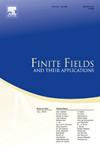On self-dual completely regular codes with covering radius ρ ≤ 3
IF 1.2
3区 数学
Q1 MATHEMATICS
引用次数: 0
Abstract
We give a complete classification of self-dual completely regular codes with covering radius . For the results are almost trivial. For , by using properties of the more general class of uniformly packed codes in the wide sense, we show that there are two sporadic such codes, of length 8, and an infinite family, of length 4, apart from the direct sum of two self-dual completely regular codes with , each one. For , in some cases, we use similar techniques to the ones used for . However, for some other cases we use different methods, namely, the Pless power moments which allow to us to discard several possibilities. We show that there are only two self-dual completely regular codes with and , which are both ternary: the extended ternary Golay code and the direct sum of three ternary Hamming codes of length 4. Therefore, any self-dual completely regular code with and is ternary and has length 12.
We provide the intersection arrays for all such codes.
关于覆盖半径 ρ ≤ 3 的自双完全正则码
给出了覆盖半径ρ≤3的自对偶完全正则码的完全分类。对于ρ=1,结果几乎是微不足道的。对于ρ=2,利用广义上更一般的一类均匀填充码的性质,我们证明了除了ρ=1的两个自对偶完全正则码的直接和外,还有两个离散的长度为8的编码和一个无限族长度为4的编码。对于ρ=3,在某些情况下,我们使用与ρ=2类似的技术。然而,对于其他一些情况,我们使用不同的方法,即无功矩,这允许我们放弃几种可能性。我们证明了ρ=3且d≥3的自对偶完全正则码只有两个都是三元的:扩展三元Golay码和三个长度为4的三元Hamming码的直和。因此,任何d≥3且ρ=3的自对偶完全正则码都是三进制的,长度为12。我们为所有这些代码提供交集数组。
本文章由计算机程序翻译,如有差异,请以英文原文为准。
求助全文
约1分钟内获得全文
求助全文
来源期刊
CiteScore
2.00
自引率
20.00%
发文量
133
审稿时长
6-12 weeks
期刊介绍:
Finite Fields and Their Applications is a peer-reviewed technical journal publishing papers in finite field theory as well as in applications of finite fields. As a result of applications in a wide variety of areas, finite fields are increasingly important in several areas of mathematics, including linear and abstract algebra, number theory and algebraic geometry, as well as in computer science, statistics, information theory, and engineering.
For cohesion, and because so many applications rely on various theoretical properties of finite fields, it is essential that there be a core of high-quality papers on theoretical aspects. In addition, since much of the vitality of the area comes from computational problems, the journal publishes papers on computational aspects of finite fields as well as on algorithms and complexity of finite field-related methods.
The journal also publishes papers in various applications including, but not limited to, algebraic coding theory, cryptology, combinatorial design theory, pseudorandom number generation, and linear recurring sequences. There are other areas of application to be included, but the important point is that finite fields play a nontrivial role in the theory, application, or algorithm.

 求助内容:
求助内容: 应助结果提醒方式:
应助结果提醒方式:


